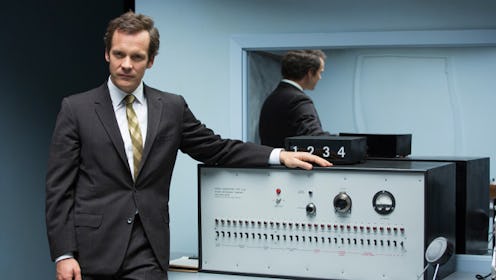
In the new film Experimenter, Peter Sarsgaard stars as social psychologist Stanley Milgram, who comes up with an experiment to try and determine why human beings are so willing to go against their own moral code when instructed to do so by a person of authority. In other words, why do people do bad things to each other even when they know it's wrong? The way Milgram conducts the experiment in the movie is by setting people up at a machine and having them ask questions to another person. Whenever that person gets an answer wrong, the person at the machine is told by Milgram to deliver an electric shock to them — even after they cry out in pain and plead for an end to the shocks. It's pretty intense, but the experiment and true story that Experimenter is based on are even crazier.
Milgram began his study, now known as the Milgram Experiment, in 1961 at Yale University. He was inspired to do so by the then-recent trial of Nazi war criminal Adolf Eichmann, one of the chief architects of the Holocaust. Milgram set out to answer popular questions that were in the zeitgeist at the time, which were: Were all of Eichmann's subordinates just following orders? What would make people do something so horrific to each other? With his famous experiment, the researcher may have found his answer.
The actual experiment consisted of three participants: The experimenter, the teacher, and the learner. The experimenter was the person conducting the experiment (makes sense), the teacher was a volunteer, and the learner was an actor pretending to be a volunteer. Before the experiment began, the volunteer and actor would draw names to see which of them would be the teacher and which would be the learner. This was rigged so that the volunteer would always be the teacher, but it gave them the sense that the experiment was fair to all. The teacher and learner would then be separated into opposite rooms where they couldn't see each other, but could still hear each other. The teacher was then instructed by the experimenter to read a series of questions along with four possible answers to the learner, and to shock the learner for each question they got wrong. The voltage of the shocks would increase with each wrong answer, culminating in a maximum shock of 450 volts.
However, the learner never actually received any shocks. Instead, they had pre-recorded painful reactions to play whenever a shock was applied, and at a predetermined time in the experiment they would bang on the wall asking the teacher to stop and complaining of a heart condition. They would then stop and go silent for the remainder of the experiment. Every teacher paused or hesitated at some point in the experiment, with many asking what the purpose was or if they could check on the learner. Despite their worry, though, 65 percent ended up seeing the experiment through to the end, which consisted of delivering the maximum shock of 450 volts three times. The only way the experiment would end before reaching this point was if the teacher refused to go on after receiving these four instructions from the experimenter:
- Please continue.
- The experiment requires that you continue.
- It is absolutely essential that you continue.
- You have no other choice, you must go on.
Milgram first published his findings in 1963 in the Journal of Abnormal and Social Psychology, and then with more detail in his 1974 book Obedience to Authority: An Experimental View . Based upon the results of the Milgram Experiment, it became clear that many Nazis did what they did because they felt they were "following orders," despite likely knowing how wrong their actions were. It's a scary realization about human nature, ad how far people can go if an authority figure is pushing them along.
Milgram went on to conduct another famous experiment, one with a much happier outcome. The phrase "six degrees of separation" became popular after his Small World Experiment, which found that on average, everyone in the U.S. is connected to each other person in the country by about six people. Might I suggest that if a sequel to Experimenter is produced based upon this experiment, that Kevin Bacon be given a role? It just seems right.
Images: Magnolia Pictures; Giphy (2)